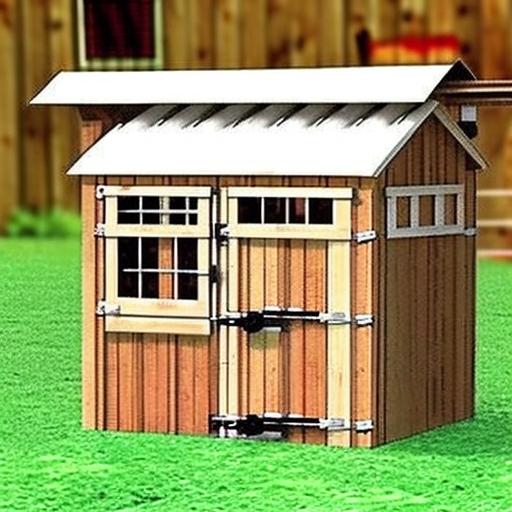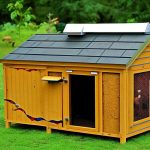Raising chickens has become increasingly popular in recent years, and for good reason. Not only do chickens provide fresh eggs, but they also make great pets and can even help with pest control in your garden. However, in order to keep your chickens safe and healthy, it is important to provide them with a proper living space. This is where a chicken coop run comes in.
A chicken coop run is an enclosed area that allows your chickens to roam freely while still being protected from predators. It provides them with the space they need to exercise, forage for food, and socialize with other chickens. Additionally, a chicken coop run helps to keep your chickens contained and prevents them from wandering off into areas where they could potentially get hurt or cause damage.
Factors to Consider Before Building Your Chicken Coop Run
Before you start building your chicken coop run, there are several factors that you need to consider. These factors will help you determine the best location, size, and budget for your chicken coop run.
Firstly, you need to choose the right location for your chicken coop run. It should be in an area that is easily accessible for you to clean and maintain, but also provides enough space for your chickens to roam around. It should also be away from any potential hazards such as busy roads or areas with heavy foot traffic.
Next, you need to determine the size of your chicken coop run. The size will depend on the number of chickens you plan to raise and the amount of space you have available. As a general rule of thumb, each chicken should have at least 4 square feet of space in the coop and 10 square feet in the run.
Budget is another important factor to consider. Building a chicken coop run can be done on a tight budget if you are willing to put in some time and effort. However, if you have a larger budget, you can invest in higher quality materials and additional features such as automatic doors or solar-powered lighting.
Lastly, you need to take into account the climate in your area. If you live in an area with extreme temperatures, you may need to insulate your chicken coop run or provide additional heating or cooling options. You should also consider the amount of rainfall in your area and ensure that your chicken coop run has proper drainage to prevent flooding.
Materials Needed for Building a Chicken Coop Run
Now that you have considered the factors mentioned above, it’s time to gather the materials needed for building your chicken coop run. Here is a list of the basic materials you will need:
– Lumber: This will be used to build the frame of your chicken coop run. Make sure to choose pressure-treated lumber that is resistant to rot and decay.
– Hardware cloth: This is a type of wire mesh that will be used to cover the sides and top of your chicken coop run. It is important to choose a heavy-duty hardware cloth with small openings to prevent predators from getting in.
– Nails/screws: These will be used to secure the lumber and hardware cloth together. Make sure to choose nails or screws that are appropriate for outdoor use and can withstand the elements.
– Roofing materials: You will need roofing materials such as corrugated metal or asphalt shingles to provide protection from rain and snow.
– Tools: You will need basic tools such as a saw, drill, hammer, and tape measure to build your chicken coop run. It may also be helpful to have a level and a square to ensure that everything is straight and level.
Step-by-Step Guide on Building a Chicken Coop Run
Now that you have gathered all the necessary materials, it’s time to start building your chicken coop run. Here is a step-by-step guide to help you through the process:
1. Clearing the area: Start by clearing the area where you plan to build your chicken coop run. Remove any rocks, debris, or vegetation that could interfere with the construction process.
2. Building the frame: Use the lumber to build the frame of your chicken coop run. Start by constructing the walls and then attach them to the base. Make sure to leave enough space for doors and windows.
3. Adding the hardware cloth: Once the frame is complete, attach the hardware cloth to the sides and top of your chicken coop run. Make sure to secure it tightly to prevent any gaps that predators could squeeze through.
4. Installing the roof: Use the roofing materials to install a roof over your chicken coop run. This will provide protection from rain, snow, and excessive sunlight. Make sure to secure the roofing materials properly to prevent them from being blown off by strong winds.
5. Adding doors and windows: Install doors and windows in your chicken coop run to provide easy access for cleaning and maintenance. Make sure to use hardware cloth or other predator-proof materials for windows to prevent predators from getting in.
Tips for Designing a Safe and Secure Chicken Coop Run
Designing a safe and secure chicken coop run is essential for keeping your chickens protected from predators and other potential dangers. Here are some tips to help you design a safe and secure chicken coop run:
1. Choosing the right location: As mentioned earlier, choosing the right location for your chicken coop run is crucial. It should be away from potential hazards such as busy roads or areas with heavy foot traffic. It should also be easily accessible for cleaning and maintenance.
2. Adding fencing: In addition to the hardware cloth, you may want to consider adding fencing around your chicken coop run. This will provide an extra layer of protection against predators such as dogs or raccoons.
3. Installing predator-proof features: To further protect your chickens from predators, consider installing predator-proof features such as an apron or skirt around the perimeter of your chicken coop run. This will prevent predators from digging under the fence and gaining access to your chickens.
4. Providing shade and shelter: Make sure to provide shade and shelter inside your chicken coop run. This can be done by adding a covered area or planting trees or shrubs that provide shade. This will help to keep your chickens cool in hot weather and protect them from extreme temperatures.
How to Choose the Right Size for Your Chicken Coop Run
Choosing the right size for your chicken coop run is important for the health and well-being of your chickens. Here are some factors to consider when determining the size of your chicken coop run:
1. Calculating the space needed per chicken: As a general rule of thumb, each chicken should have at least 4 square feet of space in the coop and 10 square feet in the run. This will provide enough space for them to move around comfortably and engage in natural behaviors such as scratching and dust bathing.
2. Considering the number of chickens you plan to raise: The number of chickens you plan to raise will also determine the size of your chicken coop run. Make sure to take into account any future expansion plans as well.
3. Planning for future expansion: If you plan to expand your flock in the future, it is important to plan for this when designing your chicken coop run. Make sure to leave enough space for additional chickens and consider how this will affect the overall layout and functionality of your chicken coop run.
How to Protect Your Chickens from Predators
Protecting your chickens from predators is one of the most important aspects of owning chickens. Here are some tips on how to protect your chickens from predators:
1. Identifying common predators: It is important to be aware of the common predators in your area so that you can take appropriate measures to protect your chickens. Common predators include raccoons, foxes, coyotes, dogs, and birds of prey.
2. Adding predator-proof features: As mentioned earlier, adding predator-proof features such as an apron or skirt around the perimeter of your chicken coop run can help prevent predators from gaining access to your chickens. You may also want to consider adding a secure lock to the doors of your chicken coop run to prevent predators from opening them.
3. Regularly checking for signs of predators: It is important to regularly check for signs of predators such as tracks, droppings, or damage to the chicken coop run. This will allow you to take immediate action if a predator is present and prevent any potential harm to your chickens.
How to Provide Proper Ventilation in Your Chicken Coop Run
Proper ventilation is essential for maintaining a healthy and comfortable environment for your chickens. Here are some tips on how to provide proper ventilation in your chicken coop run:
1. Importance of ventilation: Proper ventilation helps to remove excess moisture, ammonia, and odors from the chicken coop run. It also helps to regulate temperature and prevent the buildup of harmful gases that can be detrimental to your chickens’ health.
2. Adding windows and vents: To provide proper ventilation, make sure to add windows and vents to your chicken coop run. Windows should be placed high up on the walls to allow hot air to escape, while vents should be placed near the floor to allow fresh air to enter.
3. Avoiding drafts: While ventilation is important, it is also important to avoid drafts that can cause cold air to blow directly onto your chickens. Make sure that windows and vents are properly sealed and that there are no gaps or cracks in the walls or roof that could allow drafts to enter.
How to Maintain a Clean and Healthy Chicken Coop Run
Maintaining a clean and healthy chicken coop run is essential for the health and well-being of your chickens. Here are some tips on how to maintain a clean and healthy chicken coop run:
1. Regular cleaning schedule: Establish a regular cleaning schedule for your chicken coop run. This should include removing any droppings, replacing bedding material, and cleaning food and water containers.
2. Proper waste disposal: Properly dispose of chicken waste to prevent the buildup of harmful bacteria and odors. Composting is a great way to recycle chicken waste and turn it into nutrient-rich fertilizer for your garden.
3. Adding bedding material: Adding bedding material such as straw or wood shavings to the floor of your chicken coop run will help absorb moisture and control odors. Make sure to regularly replace the bedding material to keep it clean and fresh.
Common Mistakes to Avoid When Building a Chicken Coop Run
When building a chicken coop run, there are some common mistakes that you should avoid. Here are a few:
1. Not considering the location: Choosing the right location for your chicken coop run is crucial. Make sure to consider factors such as accessibility, potential hazards, and proximity to your house or other buildings.
2. Not providing enough space: Chickens need plenty of space to move around and engage in natural behaviors. Make sure to provide enough space in your chicken coop run to prevent overcrowding and stress.
3. Not adding predator-proof features: Predators can pose a serious threat to your chickens. Make sure to add predator-proof features such as fencing, aprons, or secure locks to prevent predators from gaining access to your chickens.
Enjoying the Benefits of a DIY Chicken Coop Run
Building a chicken coop run is a rewarding project that allows you to provide a safe and healthy environment for your chickens. By considering factors such as location, size, budget, and climate, you can design a chicken coop run that meets the needs of your chickens and fits your lifestyle.
With the right materials, tools, and knowledge, you can build a chicken coop run that is safe, secure, and comfortable for your chickens. By following the step-by-step guide and implementing the tips mentioned in this article, you can enjoy the benefits of raising chickens and have fresh eggs right in your own backyard. So why wait? Start building your chicken coop run today and enjoy the many rewards that come with it.
Meet Walter, the feathered-friend fanatic of Florida! Nestled in the sunshine state, Walter struts through life with his feathered companions, clucking his way to happiness. With a coop that’s fancier than a five-star hotel, he’s the Don Juan of the chicken world. When he’s not teaching his hens to do the cha-cha, you’ll find him in a heated debate with his prized rooster, Sir Clucks-a-Lot. Walter’s poultry passion is no yolk; he’s the sunny-side-up guy you never knew you needed in your flock of friends!








